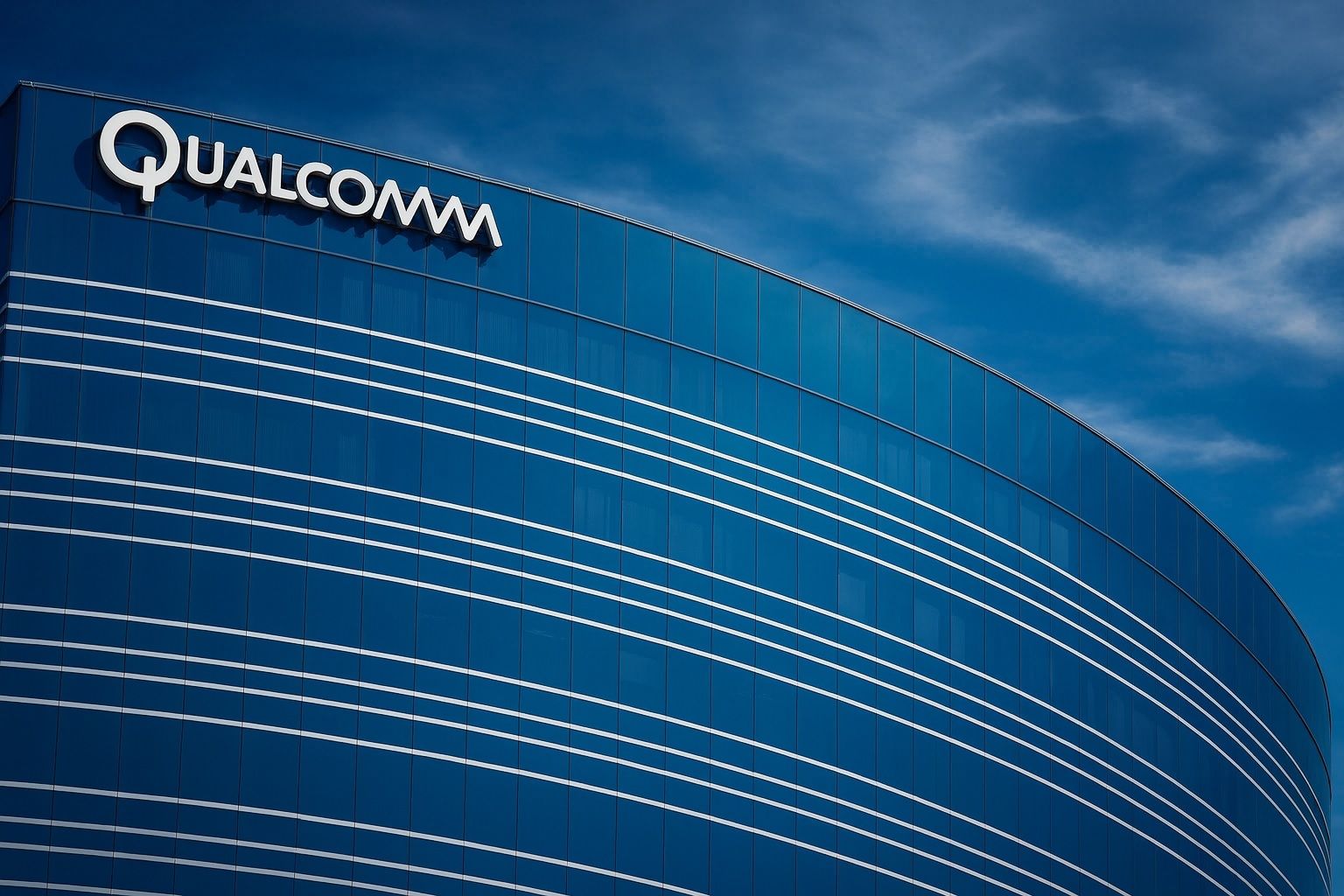Qualcomm trades around $153.6 (as of Oct 10, 2025) [1], with a market cap near $170B. The stock is roughly flat YTD (down ~4% year-on-year) [2], after hitting a 52‑week high of ~$182.1 [3]. Its valuation is relatively low for a tech name – about 15× trailing EPS and ~12× forward [4] [5], with a PEG ~1.3 (assuming ~12% annual EPS growth [6]). Qualcomm pays a $3.56 annual dividend ($0.89/qtr) for a ~2.2–2.3% yield [7] [8] (payout ~33%). Analysts are broadly bullish: consensus is a Moderate Buy (13 Buys, 10 Holds, 1 Sell) [9] with an average 12‑month target ~$183 [10] (range ~$140–225) – roughly 19% above today’s price. Qualcomm’s latest quarter (Q3 FY2025) saw $10.37B revenue (+10% YoY) and $2.77 EPS [11], driven by strong growth in its automotive and IoT chip segments. The company generates $8–10B of operating cash flow per year [12], has only modest net debt (~$5B, with ~$6–7B cash vs. ~$11–12B debt [13]), and returns capital aggressively (FY2024 buybacks ~$4.1B plus rising dividends [14] [15]).
Current Price & Recent Performance
As of mid-October 2025, Qualcomm (QCOM) closed around $153.6 [16] [17]. Over the past year the stock is nearly flat (≈–4%) [18], even as many tech peers surged. Qualcomm hit a 52-week high of about $182 in 2025 [19], but a sharp selloff this week erased much of that gain. On Oct 10, 2025, shares plunged roughly 7.3% intraday [20] after Chinese media reported an antitrust investigation. That drop contributed to a nearly 9% decline over the prior week [21]. (Investors were already uneasy about U.S.–China tensions, and President Trump’s Oct 10 comments on tariffs further rattled markets [22].) Over the longer term, Qualcomm has performed reasonably well: the stock is up over 30% in the past 5 years [23], outperforming Intel and AMD but lagging giants like Nvidia.
In summary, QCOM now trades in the mid-$150s, with its short-term momentum turned negative by this week’s China news [24] [25]. Its valuation (P/E ~15×, PEG ~1.3) is modest by tech standards [26] [27], suggesting much of the bullish case is already in the price. We next examine how analysts see the stock moving in the near and long term.
Analyst Forecasts & Ratings
Wall Street analysts are cautiously optimistic. Market consensus remains a “Moderate Buy” (13 Buys, 10 Holds, 1 Sell) [28]. The average 12-month price target is ~$182.8 [29], implying roughly 19% upside from current levels. Analysts’ targets span roughly $140 to $225 [30] [31]. For example, JPMorgan (June 2025) carries an Overweight rating with a $200 target [32], citing Qualcomm’s “executing well” across handsets, autos and IoT [33]. Rosenblatt Securities sees even more upside ($225 target) on strong diversification. On the other hand, some are cautious: TD Cowen warns that licensing pressures in China and elsewhere add “another brick to the wall of worry” for the stock [34]. UBS was more neutral (recent $165 target).
Longer-term, analysts generally forecast mid-teens EPS growth. The consensus is about 11–12% annual EPS growth [35], driven by new product cycles (5G/AI chips) and market expansion in auto/IoT. If Qualcomm can deliver on those, many see upside beyond current targets; Morningstar, for example, notes the stock “may have more growth potential than the market is pricing in” and that Qualcomm “promises it can be an AI winner” [36]. Conversely, if the core smartphone market weakens further, targets could come down. Overall, analysts’ 12-month outlook (consensus ~$183) is moderately bullish, but many caution that execution on newer businesses and geopolitical factors will make or break near-term performance.
Financial Fundamentals
Qualcomm’s financial statements remain strong. Revenue for the trailing twelve months is about $43.3B, and FY2025 is tracking around $44–45B [37]. After a brief pullback in FY2024 (due to smartphone market softness), revenues are now growing again. In Q3 FY2025 (ended June), sales were $10.37B (+10% YoY) [38]. This growth is broad-based: while handsets (mobile 5G chips) still make up ~65% of sales [39], the automotive and IoT segments are expanding rapidly (combined ~$1.68B in Q3, +23% YoY [40]). Qualcomm aims to boost auto+IoT to about half of revenue by 2029 [41], underscoring management’s focus on these new markets.
On the profit side, Qualcomm is a cash cow. Net income over the last year was about $11.6B, yielding a net profit margin ~26–27% [42]. Its gross margins are excellent (mid-50% range [43]) and operating margins in the 30%+ range. Return on equity exceeds 40% [44] (bolstered by share buybacks reducing equity). In Q3 FY2025, EPS was $2.77, slightly above consensus [45]. Guidance for Q4 FY2025 remains solid: management expects $10.3–11.1B revenue and ~$2.75–2.90 EPS [46], reflecting moderate growth continuing.
In terms of cash flow and capital return, Qualcomm shines. It generates roughly $8–10B of operating cash flow per year [47], far exceeding its modest capital expenditures (because it is fabless). The balance sheet is healthy: about $6–7B cash vs $11–12B debt (mid-2025) [48], leaving net debt ~–$5B. Debt is well structured (low cost, long-term) and interest coverage is ample [49]. The company’s debt/equity ratio is under 1.0 [50].
Qualcomm returns cash aggressively. Its dividend (~$3.56/year) represents a ~2.2–2.3% yield [51] [52], and the payout ratio is only about 33% [53]. The board approved a new $15B buyback program in 2024 [54]; in FY2024 the company repurchased ~$4.12B of stock and paid $3.69B in dividends [55]. In short, Qualcomm’s core financials are solid: strong margins, high free cash flow, low payout ratio, and conservative leverage [56] [57]. This gives it flexibility to invest in R&D and M&A (like its $0.4B Autotalks purchase) while still rewarding shareholders.
Key Growth Drivers
Qualcomm’s future hinges on several technology and market trends:
- 5G Expansion & Mobile Chips: Qualcomm is the global leader in 5G smartphone chipsets and modems. Virtually all major Android phones use Qualcomm’s Snapdragon SoCs and 5G modems, and even Apple’s iPhones relied on Qualcomm 5G modems until very recently. Worldwide 5G device connections are booming (projected in the billions by 2025), fueling demand for Qualcomm’s chips. Moreover, Qualcomm’s next-generation CPUs (based on its new Oryon core) and GPU cores will bring enhanced performance and on-device AI to mobile devices. Qualcomm’s newly announced Snapdragon X2 Elite chip for PCs also leverages its modem expertise, adding novel features like “Guardian” remote management [58]. As analyst Ben Bajarin notes, this kind of PC security feature is unique: “Nobody else can offer something like that… I can actually see that being attractive for a portion of the workforce” [59]. In short, the rollout of 5G (and eventually 6G) networks and higher-end devices should support Qualcomm’s core handset revenue for years.
- Artificial Intelligence (On-Device AI & Edge): Qualcomm has been embedding AI accelerators in its chips (the Hexagon NPU in Snapdragon, etc.) so that phones and other devices can run machine-learning tasks (voice recognition, camera enhancements, AR/VR) locally. This on-device AI market is expected to grow sharply. Qualcomm has also shown off new AI chip families (like the “Elite” series) aimed at powering mobile AI and PCs. Importantly, Qualcomm is partnering with cloud/AI players: in September 2025 it announced a collaboration with Google Cloud to bring “agentic AI” into cars [60]. Google’s Shiv Venkataraman said “AI will fundamentally redefine the carmaker’s ability to provide experiences in and around the car” [61], a vision that Qualcomm aims to realize through its hardware. Qualcomm calls this collaboration a “significant milestone” for advanced in-vehicle AI [62]. These initiatives could drive long-term upside if Qualcomm capitalizes on the next wave of AI-driven features.
- Automotive Electronics: Qualcomm is rapidly expanding into automotive chips. Its Snapdragon Automotive (and Snapdragon Ride) platforms power infotainment and advanced driver-assistance systems (ADAS). In 2025 Qualcomm unveiled the Snapdragon Ride Pilot – an AI-enabled Level 2+ driving system – which is rolling out in BMW’s new electric iX3 SUV (targeting global markets by 2026) [63]. Qualcomm’s Nakul Duggal described Snapdragon Ride Pilot as a “revolutionary driver assistance system that prioritizes safety” [64]. Auto revenues have been one of Qualcomm’s fastest-growing areas (+55% in FY2024 [65], +68% Q4; +23% Q3) and are aimed to reach $22B by 2029 [66]. The company’s automotive strategy includes silicon (Snapdragon Ride/Elite chips), software stacks (ADAS/AI algorithms), and services. As J.P. Morgan noted, Qualcomm’s execution in autos (and IoT) has been a positive surprise alongside handsets [67].
- Internet of Things (IoT) & New Devices: Beyond phones and cars, Qualcomm supplies chips for a huge range of IoT devices (modems, gateways, XR headsets, wearables, etc.). Its latest Snapdragon X Elite chips are also entering the ARM-based PC space, targeting ultraportable Windows laptops with always-on connectivity. Qualcomm sees a large opportunity as PCs and XR devices go mobile and connected. Its Snapdragon solutions for XR (e.g. Quest 3 VR headset) and Windows on ARM are part of this. The IoT/embedded segment (about 12% of Q3 sales) grew ~22% in FY2024 [68]. Partnerships like the one with Google AI (above) indicate Qualcomm’s push to make cars and devices part of a connected “cloud-to-edge” AI ecosystem.
- Licensing & Intellectual Property: Qualcomm’s patent licensing business (QTL) has historically been very profitable. Licensing revenue was ~$1.3B in Q3 (essentially flat YoY) [69]. The long-term “driver” here is Qualcomm’s portfolio of 5G/4G patents used in nearly every modern smartphone. Although Huawei’s disappearance reduced royalties, Qualcomm has inked licensing deals with other Chinese makers (like Oppo, Vivo, Xiaomi) to replace that revenue [70]. Qualcomm is also expanding licenses into tablets and PCs. While future growth is limited, licensing provides a recurring cash stream (high-margin), which management can invest in R&D and buybacks.
Together, these drivers paint Qualcomm as a diversifying tech company: still a leader in smartphone 5G chips, but also growing in AI, auto, IoT and PCs. Analysts like J.P. Morgan are bullish on this multi-pronged growth, noting that Qualcomm is “executing well…with upsides from all aspects of its business, including Handsets, Autos as well as IoT” [71]. The big question is whether 5G/AI tailwinds can overcome the hurdles below.
Competitive Position
Qualcomm sits in a crowded chip industry and faces stiff competition, but it has a strong franchise. In mobile, its Snapdragon SoCs are virtually unmatched at the high end – Android flagship phones almost all use Qualcomm CPUs and 5G modems. Its largest competitors here are MediaTek (which dominates the lower-end market – MediaTek shipped ~26% of smartphone SoCs vs Qualcomm’s ~22% in Q1 2025 [72]) and Samsung (Exynos) to a lesser extent. Unlike MediaTek, Qualcomm makes both the application processor and 5G modem, securing more design wins. Apple used Qualcomm modems in recent iPhones, though Apple is developing its own modems for the mid-2020s; that remains a key risk [73]. Qualcomm’s Snapdragon chips also compete indirectly with NVIDIA’s (which entered the mobile/auto space via ARM-based chips) and with Intel/AMD (in PCs).
In the PC market, Qualcomm is a new entrant trying to take share from Intel and AMD. Its ARM-based Snapdragon X-series processors target thin Windows laptops (focusing on battery life and 5G connectivity). They compete with Intel’s mobile CPUs and, to some extent, AMD’s. Intel and AMD still control ~90%+ of x86 PC chips [74], and Qualcomm’s PC market share is tiny. However, partnerships (e.g. Dell, HP, Asus adopting Snapdragon X) suggest potential growth. Qualcomm’s emphasis on power efficiency and always-on connectivity (plus novel features like the Guardian security chip [75]) carve out a niche, but it remains early days.
In automotive, Qualcomm is up against Nvidia and (to a lesser extent) Mobileye (Intel), NXP, and Texas Instruments. Nvidia leads in high-end autonomous driving chips, but Qualcomm has been winning design-ins for safety and infotainment systems. Qualcomm’s deep ties to Android and Google (Android Automotive OS) are an advantage in connected cars.
Financially, Qualcomm’s valuation is much lower than many peers, reflecting its market position. It trades around 15× P/E [76], whereas Nvidia’s is ~70× [77] and even AMD’s ~50×. Its PEG (~1.3 assuming 12% growth) is low. Analysts often call QCOM a “value play” in tech [78]. This relative cheapness suggests the market sees Qualcomm as less of a high-growth name and more of a stable dividend/growth hybrid. Importantly, unlike NVDA/AMD, Qualcomm does pay a dividend (~2.3%) [79], which attracts income-oriented investors.
In summary, Qualcomm dominates high-end mobile chips and is making inroads in new markets (automotive, IoT, PCs). It competes with Nvidia (for AI chips/auto), AMD/Intel (in PCs and connectivity), and MediaTek/Apple (in mobile). Its patents give it an enduring licensing franchise, but it must continually innovate to fend off rivals.
Risks & Uncertainties
Despite the positives, investors should be wary of several key risks:
- China Demand & Regulation: Qualcomm’s business is heavily exposed to China. Chinese smartphone OEMs (Xiaomi, Oppo, Vivo) are major customers, and about 20–30% of Qualcomm’s revenue comes from Chinese device makers. But the Chinese handset market has been weak, pressuring sales. More ominously, Chinese regulators have recently targeted Qualcomm. On Oct 10, 2025 Beijing’s State Administration for Market Regulation opened an antitrust probe into Qualcomm’s acquisition of Israeli auto-chip firm Autotalks [80]. Two days later, Chinese press reported Qualcomm “admitted” it had not informed regulators of the deal [81]. This saga raises the specter of fines or forced divestiture. It also comes amid broader U.S.–China tech tensions (e.g. Trump’s Oct 2025 threats to raise tariffs, China’s new export controls on rare earths) [82] [83]. Any sanctions or delays could hit Qualcomm’s supply chain or sales. As Supply Chain Brain warns, these moves suggest both sides are using Qualcomm as a bargaining chip in trade talks [84].
- Licensing Uncertainties: Qualcomm’s high-margin licensing (QTL) faces headwinds. The loss of Huawei’s royalties was a one-time hit that flattened licensing revenue. Qualcomm has secured deals with other Chinese brands to offset it [85], but nothing on Huawei’s scale is forthcoming. Worse, major licensees like Apple may eventually drop Qualcomm. Apple is developing its own 5G modem and is widely expected to migrate away from Qualcomm by the mid-2020s [86]. If Apple cuts Qualcomm off, Qualcomm would lose a valuable licensing and modem customer. Moreover, Qualcomm is embroiled in ongoing patent disputes: notably, Arm (whose architecture Qualcomm’s Nuvia CPU relies on) had sued Qualcomm. Although Qualcomm just won a decisive victory in court [87], any appeal or future licensing claim by Arm or others could reignite legal battles and uncertainty.
- Intense Competition: As noted, Qualcomm faces fierce competition. On the AI/automotive front, Nvidia’s aggressive expansion could take share in future high-end auto chips. In mobile, MediaTek has shown it can win design-ins on a volume basis (especially at mid/low tiers). If MediaTek’s performance or pricing outpace Qualcomm, Android OEMs could shift. In PCs, Qualcomm must prove ARM-based laptops can really compete on performance and compatibility with entrenched Intel/AMD ecosystems. Any misstep in product execution could cede ground.
- Supply Chain & Geopolitics: Qualcomm relies on third-party foundries (TSMC, Samsung) for chip manufacturing. Any shortages of advanced nodes or U.S. export restrictions (e.g. if new rules hit Chinese foundries) could hamper production. Geopolitical tensions also raise concerns: Qualcomm’s chips are a U.S. technology, subject to export controls. For example, U.S. bans on certain China tech (like drones) could evolve to cover more semiconductors. Such macro risks could constrain growth or margins.
- Market Cyclicality & Macro: Finally, the semiconductor industry is cyclical. A global economic downturn or another dip in smartphone upgrades could hurt Qualcomm. Its valuation implies relatively modest growth; if Qualcomm fails to deliver new engines of growth (AI on device, auto), the stock could stagnate or retreat. As one analyst put it, these uncertainties are “another brick in the wall of worry” [88] that investors must climb.
Major News (Past Week)
Several notable headlines emerged in the week ending Oct 13, 2025:
- China Antitrust Probe (Oct 10, 2025): China’s SAMR announced it was examining Qualcomm’s June 2025 acquisition of Autotalks, a small Israeli automotive-chip maker [89]. This is a rare move – Qualcomm had informed regulators it would abandon further action, yet completed the deal without Chinese approval. The news immediately hit the stock: QCOM shares fell sharply on Oct 10 [90] (and roughly 4–5% intraday) after the news.
- Qualcomm Admitted Non-Compliance (Oct 12): On Oct 12 Reuters reported that Qualcomm “admitted” it closed the Autotalks deal without notifying Chinese authorities [91]. SAMR confirmed it had warned Qualcomm back in March 2024 to obtain approval, and now notes the company “acknowledged” that it did not. This hard confirmation intensified sell pressure: shares slid another ~5% on Oct 12 [92] (amid broader Trump–China trade headlines).
- Industry Context: Aside from Qualcomm-specific news, the past week also saw broader chip-sector developments. (For context, NVIDIA and Broadcom are also facing Chinese scrutiny – e.g. China investigated Nvidia/Mellanox in Sept.) On the product side, Qualcomm’s recent launches underscore its strategy (though these came slightly earlier): in late September Qualcomm unveiled the Snapdragon X2 Elite PC processor with a unique security coprocessor [93]. And in early September it announced a major AI partnership with Google Cloud for automotive “AI Agents” [94]. While these weren’t past-week news, they set the stage for future growth.
- Market Reaction: The immediate news flow was bearish. Qualcomm’s after-hours quotes on Oct 10 show a slide into $153.6 [95], with short-term technicals breaking bearish. Investors now await official Q3 fiscal results (due late October) and further updates on the China probe.
Expert Commentary
Analysts and executives have offered mixed but insightful commentary on Qualcomm’s outlook:
- Analyst Sentiment: J.P. Morgan analysts praised Qualcomm’s execution, noting the company “is executing well in its own right with upsides from all aspects of its business, including Handsets, Autos as well as IoT” [96]. In other words, JPMorgan sees Qualcomm’s diversified businesses (phones, auto chips, IoT devices) all performing better than expected. In contrast, TD Cowen’s analysts highlighted the risks, warning that a China licensing slowdown is “another brick to the wall of worry facing the stock” [97] – reflecting regulatory and competitive uncertainties. Independent research firm Morningstar emphasized Qualcomm’s AI potential, writing that Qualcomm “promises it can be an AI winner” as it stacks AI accelerators into its chips [98]. These views illustrate the bullish case (strong execution and new growth avenues) versus the cautious case (regulatory and competitive hurdles).
- Industry Experts: Tech analysts have also weighed in. Creative Strategies’ Ben Bajarin commented on Qualcomm’s new PC processors, noting that its unique security feature (“Guardian” remote management) sets it apart: “Nobody else can offer something like that. I can actually see that being attractive for a portion of [the enterprise] workforce” [99]. This implies Qualcomm could gain traction in corporate PCs by emphasizing features others lack.
- Qualcomm Executives: Qualcomm’s leadership has highlighted the company’s technology roadmap. Group GM Nakul Duggal spoke to its automotive strategy, calling Snapdragon Ride Pilot a “revolutionary driver assistance system that prioritizes safety” [100]. He and others emphasize that Qualcomm is at the forefront of bringing AI to cars. Similarly, Qualcomm has touted its collaboration with Google Cloud: as Duggal put it, the partnership is “a significant milestone in unlocking new possibilities for automakers”, empowering them with AI-driven experiences [101]. These executive comments reinforce that Qualcomm sees AI and automotive as major future catalysts.
- Market Commentary: Some market observers have noted the valuation disconnect: for example, Simply Wall St recently calculated Qualcomm’s fair value at ~$193 (20% above current price) based on discounted cash flows and projected growth, implying QCOM is undervalued [102]. Others caution that many fundamentals (like licensing or macro trends) are already reflected in the low P/E. In sum, experts are split: bullish on long-term tech trends (5G, AI, auto) and Qualcomm’s execution, but wary of China/regulatory risks. As one summary put it, Qualcomm’s stock faces a “wall of worry” – if it clears that wall with good results, shares could see a significant re-rating.
Sources: Author’s analysis based on Qualcomm financial reports and guidance, Reuters and Investopedia news articles (on China probe and earnings) [103] [104], investment research (MarketBeat consensus data [105] [106]; TS2.tech Qualcomm analysis [107] [108]; Simply Wall St valuation [109]), and press releases/newswire announcements by Qualcomm and partners [110] [111] [112]. Expert quotes are from analysts’ comments in media and press releases [113] [114] [115]. All data and quotes are from public sources as cited.
References
1. ts2.tech, 2. ts2.tech, 3. ts2.tech, 4. ts2.tech, 5. ts2.tech, 6. ts2.tech, 7. ts2.tech, 8. ts2.tech, 9. www.marketbeat.com, 10. www.marketbeat.com, 11. ts2.tech, 12. ts2.tech, 13. ts2.tech, 14. s204.q4cdn.com, 15. ts2.tech, 16. ts2.tech, 17. www.marketbeat.com, 18. ts2.tech, 19. ts2.tech, 20. www.marketbeat.com, 21. simplywall.st, 22. www.reuters.com, 23. simplywall.st, 24. www.marketbeat.com, 25. simplywall.st, 26. ts2.tech, 27. ts2.tech, 28. www.marketbeat.com, 29. www.marketbeat.com, 30. www.marketbeat.com, 31. www.marketbeat.com, 32. www.marketbeat.com, 33. www.reuters.com, 34. ts2.tech, 35. ts2.tech, 36. ts2.tech, 37. ts2.tech, 38. ts2.tech, 39. ts2.tech, 40. ts2.tech, 41. ts2.tech, 42. ts2.tech, 43. ts2.tech, 44. ts2.tech, 45. ts2.tech, 46. ts2.tech, 47. ts2.tech, 48. ts2.tech, 49. ts2.tech, 50. ts2.tech, 51. ts2.tech, 52. ts2.tech, 53. ts2.tech, 54. s204.q4cdn.com, 55. s204.q4cdn.com, 56. ts2.tech, 57. ts2.tech, 58. www.reuters.com, 59. www.reuters.com, 60. www.prnewswire.com, 61. www.prnewswire.com, 62. www.prnewswire.com, 63. www.businesswire.com, 64. www.businesswire.com, 65. s204.q4cdn.com, 66. ts2.tech, 67. www.reuters.com, 68. s204.q4cdn.com, 69. ts2.tech, 70. www.reuters.com, 71. www.reuters.com, 72. gizmochina.beehiiv.com, 73. ts2.tech, 74. ts2.tech, 75. www.reuters.com, 76. ts2.tech, 77. ts2.tech, 78. ts2.tech, 79. ts2.tech, 80. www.investopedia.com, 81. www.reuters.com, 82. www.supplychainbrain.com, 83. www.reuters.com, 84. www.supplychainbrain.com, 85. www.reuters.com, 86. ts2.tech, 87. investor.qualcomm.com, 88. ts2.tech, 89. www.investopedia.com, 90. www.marketbeat.com, 91. www.reuters.com, 92. www.reuters.com, 93. www.reuters.com, 94. www.prnewswire.com, 95. www.marketbeat.com, 96. www.reuters.com, 97. ts2.tech, 98. ts2.tech, 99. www.reuters.com, 100. www.businesswire.com, 101. www.prnewswire.com, 102. simplywall.st, 103. www.investopedia.com, 104. www.reuters.com, 105. www.marketbeat.com, 106. www.marketbeat.com, 107. ts2.tech, 108. ts2.tech, 109. simplywall.st, 110. www.reuters.com, 111. www.businesswire.com, 112. www.prnewswire.com, 113. www.reuters.com, 114. ts2.tech, 115. ts2.tech









